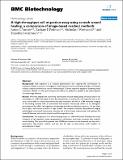| dc.contributor.author | Yarrow, Justin C | |
| dc.contributor.author | Perlman, Zachary E | |
| dc.contributor.author | Westwood, Nicholas J | |
| dc.contributor.author | Mitchison, Timothy J. | |
| dc.date.accessioned | 2011-03-09T04:09:42Z | |
| dc.date.issued | 2004 | |
| dc.identifier.citation | Yarrow, Justin C, Zachary E Perlman, Nicholas J Westwood, and Timothy J Mitchison. 2004. A high-throughput cell migration assay using scratch wound healing, a comparison of image-based readout methods. BMC Biotechnology 4: 21. | en_US |
| dc.identifier.issn | 1472-6750 | en_US |
| dc.identifier.uri | http://nrs.harvard.edu/urn-3:HUL.InstRepos:4739592 | |
| dc.description.abstract | Background: Cell migration is a complex phenomenon that requires the coordination of numerous cellular processes. Investigation of cell migration and its underlying biology is of interest to basic scientists and those in search of therapeutics. Current migration assays for screening small molecules, siRNAs, or other perturbations are difficult to perform in parallel at the scale required to screen large libraries. Results: We have adapted the commonly used scratch wound healing assay of tissue-culture cell monolayers to a 384 well plate format. By mechanically scratching the cell substrate with a pin array, we are able to create characteristically sized wounds in all wells of a 384 well plate. Imaging of the healing wounds with an automated fluorescence microscope allows us to distinguish perturbations that affect cell migration, morphology, and division. Readout requires ~1 hr per plate but is high in information content i.e. high content. We compare readouts using different imaging technologies, automated microscopy, scanners and a fluorescence macroscope, and evaluate the trade-off between information content and data acquisition rate. Conclusions: The adaptation of a wound healing assay to a 384 well format facilitates the study of aspects of cell migration, tissue reorganization, cell division, and other processes that underlie wound healing. This assay allows greater than 10,000 perturbations to be screened per day with a quantitative, high-content readout, and can also be used to characterize small numbers of perturbations in detail. | en_US |
| dc.language.iso | en_US | en_US |
| dc.publisher | BioMed Central | en_US |
| dc.relation.isversionof | doi:10.1186/1472-6750-4-21 | en_US |
| dc.relation.hasversion | http://www.ncbi.nlm.nih.gov/pmc/articles/PMC521074/pdf/ | en_US |
| dash.license | LAA | |
| dc.subject | Endothelial Cells | en_US |
| dc.subject | In-Vitro | en_US |
| dc.subject | Polarity | en_US |
| dc.subject | Overexpression | en_US |
| dc.subject | Proliferation | en_US |
| dc.subject | Involvement | en_US |
| dc.subject | Activation | en_US |
| dc.subject | Astrocytes | en_US |
| dc.subject | Cancer | en_US |
| dc.title | A high-throughput cell migration assay using scratch wound healing, a comparison of image-based readout methods | en_US |
| dc.type | Journal Article | en_US |
| dc.description.version | Version of Record | en_US |
| dc.relation.journal | BMC Biotechnology | en_US |
| dash.depositing.author | Mitchison, Timothy J. | |
| dc.date.available | 2011-03-09T04:09:42Z | |
| dash.affiliation.other | HMS^Systems Biology | en_US |
| dc.identifier.doi | 10.1186/1472-6750-4-21 | * |
| dash.contributor.affiliated | Mitchison, Timothy | |


